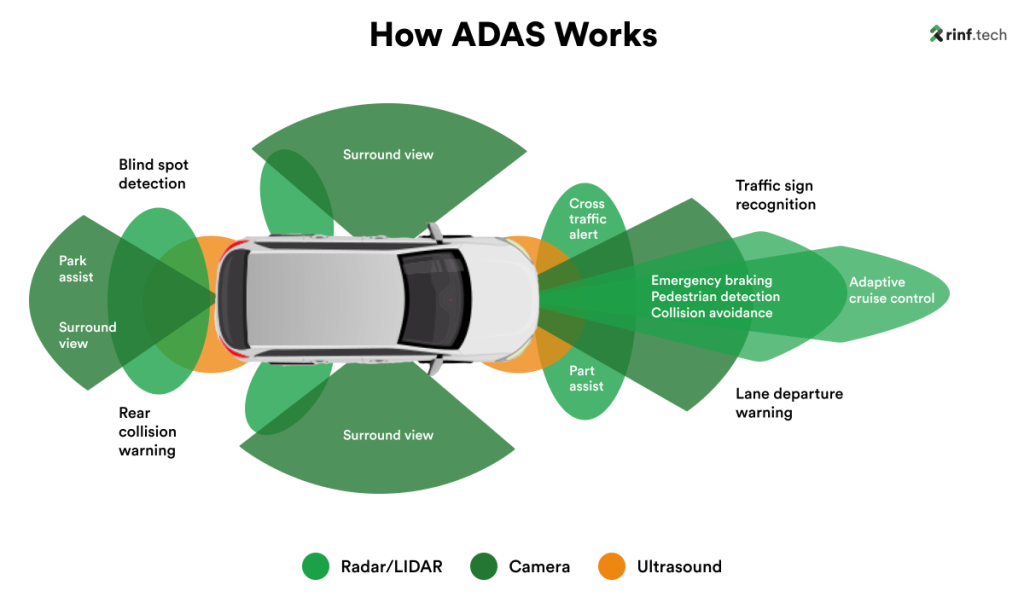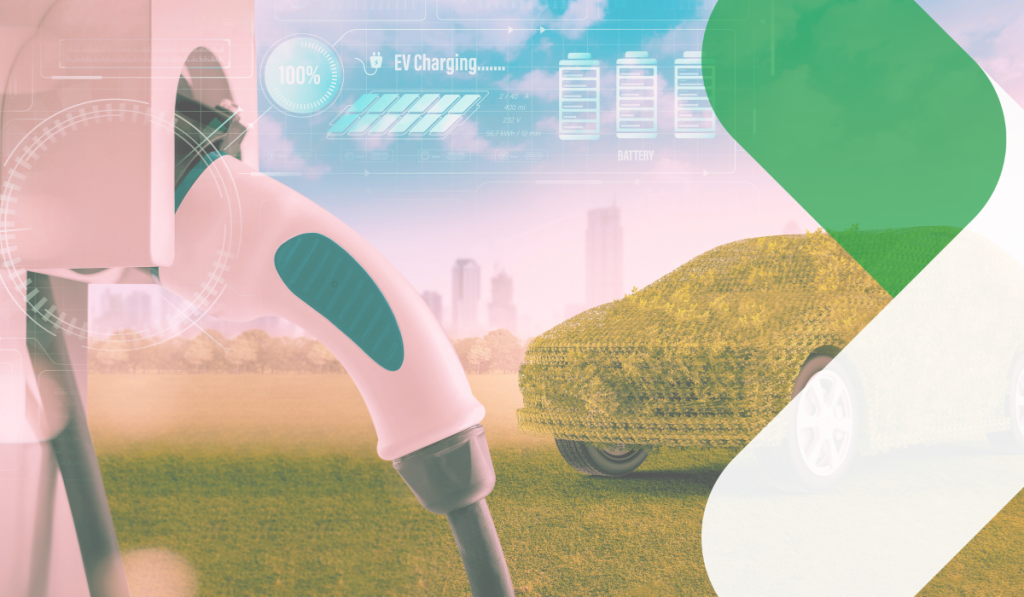
AI-Powered LiDAR: A New Era of Perception
How AI and ML enhance LiDAR technology by overcoming data processing challenges, enabling advanced applications in autonomous systems, robotics, and 3D mapping, and more.
The ADAS market is forecasted to reach $60.1 billion by 2030, growing at a compound annual growth rate of 9.7% from 2022. Major companies in the US and Europe currently dominate the industry, but the Asia Pacific region is set to become the biggest ADAS market in the world.
ADAS is blossoming in the Asia Pacific because of the automobile megamarkets in Japan, China, India, and South Korea and government-backed road safety initiatives in some of the nations mentioned above. The increasing global demand for autonomous vehicles is also a significant driver for this industry.
This article will scope the current trends of advanced driver assistance systems, identify key ADAS components, and briefly explore its potential future.
ADAS sensors allow vehicles to process their surrounding environments to either report about or respond to them. Ultramodern microprocessors and data processing technologies power ADAS sensors. Examples of ADAS sensors include Lidar (Light Detection and Ranging) sensors, 360° camera systems and computer vision-powered tools, and radar sensors, which are primarily used to avoid collisions.
ADAS technology transforms vehicles into computers. An evolving list of ML and AI technologies provides vehicles with the computational capabilities to perceive and respond to their surroundings. Large volumes of data are collected from ADAS sensors, and only AI-powered ML can analyze that data at sub-second speeds. Examples of AI/ML in ADAS include deep learning algorithms for object recognition and predictive analytics to study drivers’ behaviors.
Vehicle connectivity refers to the ability of vehicles to exchange information with various infrastructures and connected devices (including other automobiles). The term V2X (Vehicle to Everything) is used to describe different kinds of vehicle connectivity and communication. Some V2X subcategories include V2C (Vehicle to Cloud), V2V (Vehicle to Vehicle), V2N (Vehicle to Network), V2I (Vehicle to Infrastructure), and V2G (Vehicle to Grid).
AUTOSAR provides standardized specifications to develop automotive software applications. AUTOSAR’s structure is threefold and comprises an application layer, a runtime environment (RTE), and a basic software layer (BSW). The latter is further divided into a service layer, an ECU abstraction layer, and a microcontroller abstraction layer.
At rinf.tech, our software and hardware engineering experts are pioneering advancements in the AUTOSAR front, which is best seen in DCDC Converter projects that involve porting a customer platform into an AUTOSAR solution and automating unit testing for software components.
An instrument cluster (commonly referred to as a dashboard) for vehicles typically includes fuel gauges, speedometers, oil pressure gauges, tachometers, and odometers. Next-gen ADAS instrument clusters that provide more advanced, seamless, and user-friendly parameter visualizations can be a game-changer for the automotive industry.
rinf.tech innovated an instrument cluster solution for two of the biggest global car manufacturers. Our experts worked on software development, AUTOSAR modules integration, hardware bring-up for new hardware instrument clusters, and vector tools for AUTOSAR. Key results of the instrument cluster solution include 1600+ tickets, more than 38 newly developed features, 50% faster deployment, and 100% compliance.
ACC is a technology that leverages sensors to ensure that a vehicle automatically maintains a safe distance from other vehicles and surrounding objects. The two primary kinds of ACC include radar-based ACC systems and laser-based ACC systems. Current challenges of ACC that are being put under the scanner by experts and innovators include inconsistent performance during harsh weather conditions and high-traffic environments.
LDW is a mechanism that provides warnings in the form of vibrations, dashboard visuals, or audio to indicate that a vehicle is about to cross over lane markings and divert from its lane. LKA provides steering support to help drivers stay within their lane. These two technologies are often connected so that they can be activated together and work in unison to better protect a vehicle and its driver.
AEB identifies an impending collision and takes autonomous action to activate a vehicle’s brakes. AEB makes this decision based on its understanding of whether or not a driver is attempting to avoid the collision and whether that attempt is on time or delayed. AEB can help drivers completely avoid collisions and accidents. In extreme cases, such as unavoidable accidents, AEB can ensure that there’s minimal damage suffered.
Blind spots have long been an area of concern for drivers. BSD tackles the blind spot challenge with the help of advanced sensors that transmit visual information of objects in blind spots to the driver’s dashboard. BSD also warns drivers with alarms, alerts, or vibrations when there’s potential trouble in a blind spot.
Every country has its own list of federally-approved traffic and road signs. Ignoring these important signs could lead to serious accidents. TSR recognizes road signs and alerts drivers who may have missed or ignored those signs via a vehicle’s instrument cluster. Simple speed and stop signs are easy for TSR mechanisms to identify. Advanced models are being developed to identify a wider array of road signs.

The SAE (Society of Automotive Engineers) established the J 3016-2018 guidelines that articulated six levels of automated driving. It begins at Level 0, which features zero automation, and covers steps including Driving Automation Assistance, Partial Driving Automation, and Conditional Driving Automation. The final level is Full Driving Automation, meaning humans don’t need to manually drive unless they want to.
Autonomous driving and increasing level progressions are becoming common, which means that systems designed to enhance drivers’ safety and performance will be elevated to the forefront of the industry. The future looks bright for ADAS development.
ADAS is being integrated with a series of emerging technologies. Cost-low, high-bandwidth 5G connectivity is likely to boost every aspect of ADAS development and end-use. There is also a significant overlap between ADAS and edge computing, meaning that vehicle data can be collected and processed in real-time and with greater efficiency.
There is likely to be a widespread crossover between ADAS and augmented reality (AR) technologies like virtual heads-up displays. AR can be a powerful safety mechanism in ADAS and transform the experience of drivers around the world.
ADAS development will also witness more collaborations between OEMs and tech companies. Cross-industry partnerships are already underway. Various standardizations, as well as measures and mechanisms to ensure interoperability, are being prioritized. ADAS development is a global phenomenon that will transform drivers’ safety, experiences, and lives.
The benefits and impact of ADAS are multifold. ADAS can greatly improve security for drivers, mitigate human errors, enhance driving experiences, increase convenience and comfort, and reduce driver fatigue. ADAS can also positively impact the environment via fuel efficiency, emissions reductions, and the optimization of traffic flow.
The current trends of ADAS include sensor technologies, AI-powered ML, advanced connectivity and communication, and AUTOSAR. Key components of ADAS include instrument clusters, adaptive cruise control, lane departure warnings, lane keep assists, autonomous emergency braking, blind spot detection, and traffic sign recognition.
The future of ADAS solutions for vehicles is promising. However, a few challenges, including technical limitations, unreliable systems, government and industry regulations, legal constraints, and cybersecurity and data privacy concerns, must be mitigated for the ADAS industry to reach its peak. (rinf.tech has extensively researched cybersecurity in the automotive industry, as illustrated here.)
rinf.tech is the perfect partner to develop and utilize cutting-edge tools and technologies for advanced driver assistance systems development. ADAS technology can profoundly transform businesses and we at rinf.tech will ensure that any ADAS-powered transformation is bound by clarity, strategy, and precision.

How AI and ML enhance LiDAR technology by overcoming data processing challenges, enabling advanced applications in autonomous systems, robotics, and 3D mapping, and more.

Offering insights into how the latest AI advancements will impact consumers, manufacturers, and the broader environment in 2025 and beyond.

Showcasing the environmental and economic benefits of integrating sustainable materials and robust recycling practices into the automotive value chain.
Copyright © 2023 rinf.tech. All Rights Reserved.
Terms & Conditions. Cookie Policy. Privacy Policy.
Politica Avertizari de Integritate (RO)